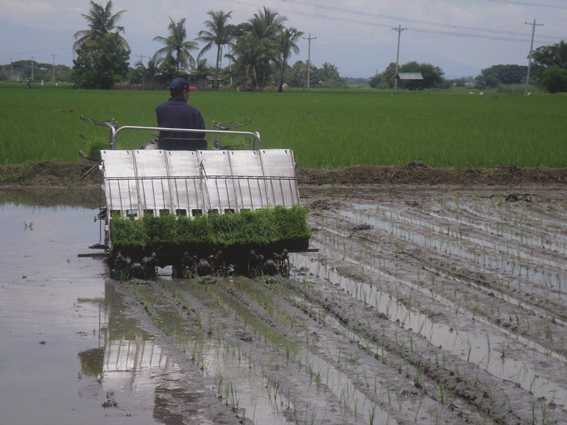 Science City of Muñoz, Nueva Ecija – PhilRice engineers developed a local riding-type rice transplanter that can double efficiency while reducing farmers’ cost in rice production.
Science City of Muñoz, Nueva Ecija – PhilRice engineers developed a local riding-type rice transplanter that can double efficiency while reducing farmers’ cost in rice production.
“The team started with the existing technology from Japan. The only problem is the availability of its spare parts since it is imported. If it’s locally manufactured, spare parts would be available here,” Engr. Arnold S. Juliano, head of PhilRice’s Rice Engineering and Mechanization Division explains.
Replacing the traditional lipat-tanim or manual transplanting method, which requires 20 to 25 man-days to work per hectare, the local riding-type rice transplanter only needs at least an operator and a helper to plant 2 ha/day. It can also cut the cost on labor and seed requirement.
The machine’s seeding rate is 40kg/ha that ensures equal spaces between seedlings when transplanted. This method can increase expected yield compared with the manual transplanting method.
Juliano and his team started to develop the machine in 2013 and the first functional prototype was completed in 2014.
Commercialization
The machine is being pilot tested in Nueva Ecija. Two more machines are being built to be pilot tested near PhilRice Negros and PhilRice Midsayap.
Juliano said they can push through with the technical design of the machine for commercialization. Meanwhile, they partnered with local manufacturers in terms of resources.
“We partnered with the Metalworking Industries Association of the Philippines in San Pedro, Laguna to manufacture the major machine components. Aside from manufacturing major components, the manufacturer signified interest to fabricate and assemble the whole unit. That’s what we did to build the units for Visayas and Mindanao,” Juliano says.
If commercialized, the machine will be available for only P750, 000, which is more affordable than Japan’s transplanter that costs P1-1.3 M.
Since the riding-type transplanter is still on its pilot testing stage, Juliano and the team expect for good results to proceed to the next level.
“If the results of the pilot-testing are good, we can have funds for its commercialization. Then we can identify manufacturers nationwide,” Juliano says.
The development of the machine was funded by the Philippine Council for Agriculture, Aquatic and Natural Resources Research and Development – Department of Science and Technology.




